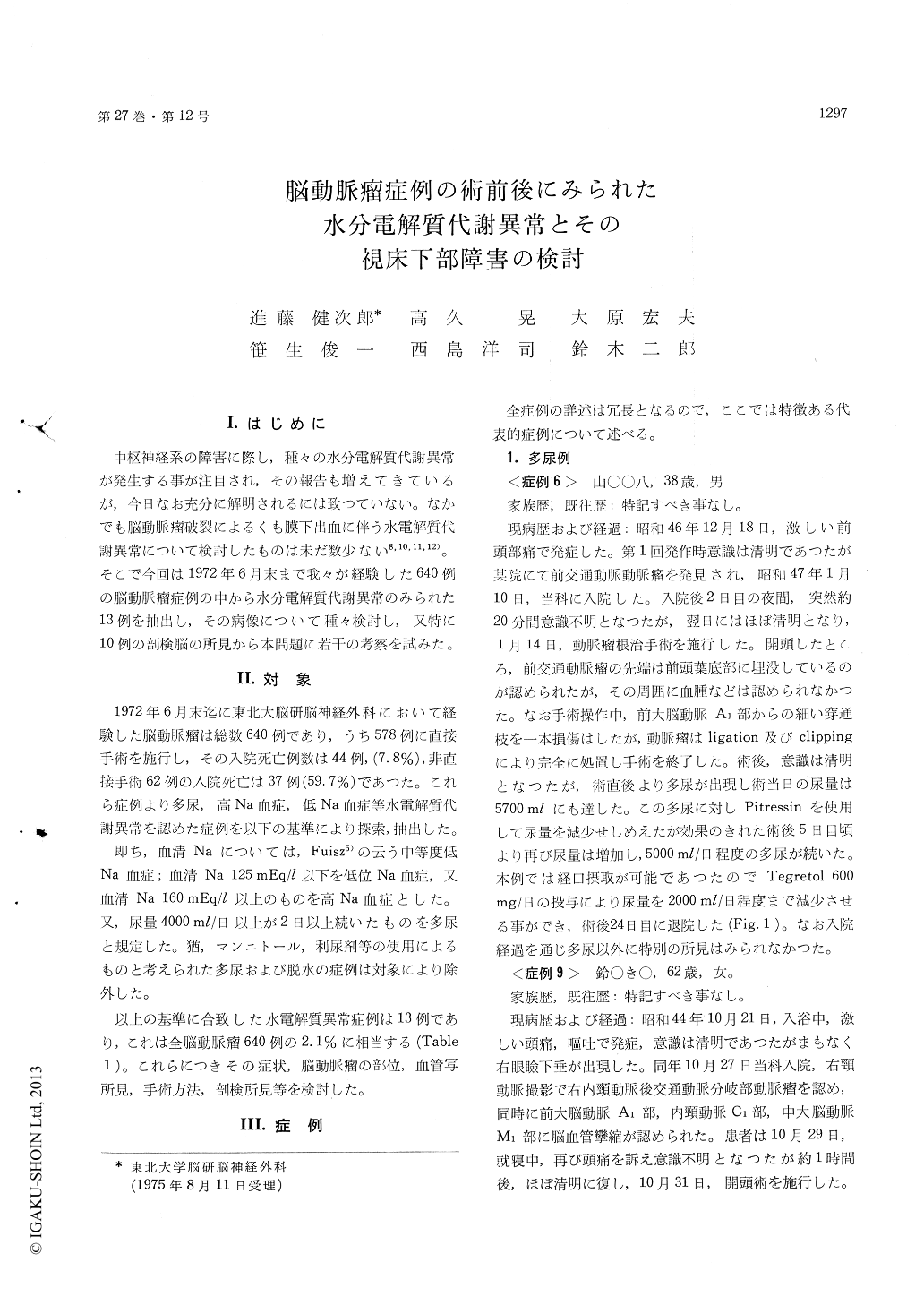Japanese
English
- 有料閲覧
- Abstract 文献概要
- 1ページ目 Look Inside
I.はじめに
中枢神経系の障害に際し,種々の水分電解質代謝異常が発生する事が注目され,その報告も増えてきているが,今日なお充分に解明されるには致つていない。なかでも脳動脈瘤破裂によるくも膜下出血に伴う水電解質代謝異常について検討したものは未だ数少ない8,10,11,12)。そこで今回は1972年6月末まで我々が経験した640例の脳動脈瘤症例の中から水分電解質代謝異常のみられた13例を抽出し,その病像について種々検討し,又特に10例の剖検脳の所見から本問題に若干の考察を試みた。
A number of papers have been available on thesigns and symptoms of intracranial aneurysm, butfluid and electrolyte disturbances in the cases withruptured intracranial aneurysm have seldom been reported.
In our series of intracranial aneurysms of 644cases up to the end of June, 1972, fluid and electro-lyte disturbances were observed in 13 cases. Fivepatients showed polyuria more than 4,000 ml/daywhich continued more than 2 days, 5 showed hyper-natremia more than 160 mEq/l and 7 suffered fromhyponatremia below 125 mEq/l. Three out of 5cases with polyuria were associated with eitherhypernatremia or hyponatremia. In 8 cases, thesedisturbances initiated after the direct operation.The site-distribution of aneurysms was characterizedby a high incidence of anterior communicatingartery (8 cases), followed by internal carotid artery(2 cases), posterior communicating artery (2 cases)and basilar artery (1 case).
Ten of 13 patients angiographically showedcerebrovascular vasospasm, most frequently at A1portion of the anterior cerebral artery. Directoperation was done in 11 cases, in which 8 diedwithin three weeks after the surgery and 3 re-covered. Two cases of huge internal carotid arteryaneurysm were considered as inoperable and diedwithin three weeks after admission. From theseresults it was concluded that the prognosis of intra-cranial aneurysms might be poor if they developfluid and electrolyte disturbances.
Autopsy was done in all of 10 dead cases, and itrevealed brain swelling in all of the cases andsevere subarachnoid hemorrhage at the basal cisternin 7 cases. In every case of autopsy hypothalamiclesion was found more or less. These lesions wereclassified into the four types, i. e. massive hemor-rhage (4 cases), micro-hemorrhage (7 cases), peri-vascular hemorrhage (6 cases) and softening (8cases). The nerve cells of the supraoptic andparaventricular nuclei, which play an importantrole of controling the fluid and electrolyte balance,showed various degrees of degeneration; pyknosis,vacuole degeneration, disappearance of nuclei anddestruction of entire cells. It seemed that fluid andelectrolyte disturbances were caused by these de-generative processes of the hypothalamus, however,no close correlation was found between the natureof hypothalamic lesion or its location and the kindof fluid and electrolyte disturbances on this study.It was also suggested that the hypothalamic lesionswere caused by cerebrovascular vasospasm of theanterior cerebral artery, from which perforatingarteries supplying blood flow to the anterior partof the hypothalamus arise.

Copyright © 1975, Igaku-Shoin Ltd. All rights reserved.


